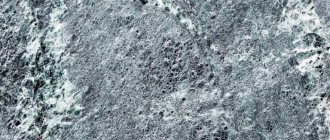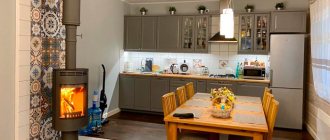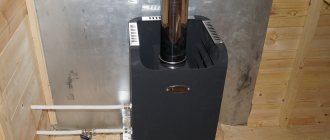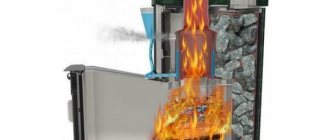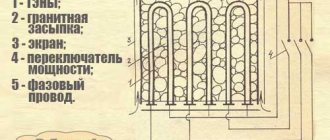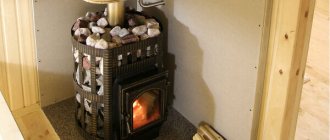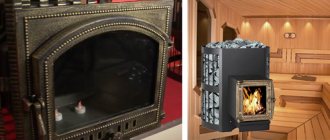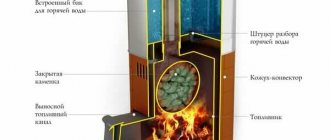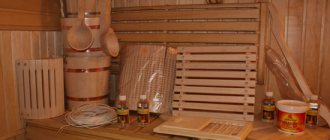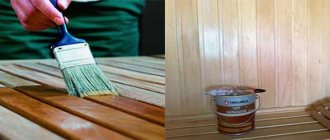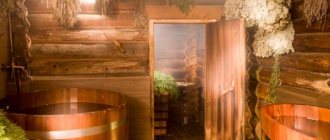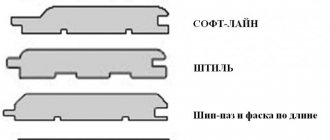Home / Bathhouse / Features of various rooms / Stove in a bathhouse - cladding options
You want to make even the smallest bathhouse not only hot, but also beautiful. This will be helped by lining the stove in the bathhouse with different materials, which will improve not only its aesthetic appeal, but in most cases will have a positive effect on the main characteristics. What is more suitable for such finishing and what advantages will this or that type of design have - you will find the answers to these questions below.
Stove in the bathhouse
The main room in the bath building is the steam room, where the temperature should be high during the procedures. Steam is no less important. In order for the steam room to function in the desired mode, the stove, the main element of the entire bath, will help to achieve the necessary parameters.
When building or purchasing a heating unit, you must pay attention to the compliance of its functionality with a number of requirements:
- quick heating of the room;
- resistance of the furnace structure to high temperatures;
- the ability to work for a long period;
- beautiful appearance.
Of no small importance for the full functioning of the furnace in the future is the quality of the materials used for its manufacture.
Types of materials
Refractory materials can be roughly divided according to the method of heat transfer:
- Heat reflective – aimed at reflecting infrared radiation into the room;
- Preventing loss due to its physical and chemical properties.
On video of fireproof materials for walls around furnaces:
But all of them can also differ in the type of raw materials from which they are produced:
- With organic components , for example, polystyrene foam materials, although their fire resistance is very low, they are best suited for walls near stoves with low heat;
- Inorganic is a broad class of non-combustible materials for insulating walls of a wide variety of fire resistance, including very flammable ones, such as wooden floors. These include stone and basalt wool, pressed into large slabs, fiberglass wool, lightweight cellular concrete slabs with fire retardant impregnations, honeycomb plastics, foamed perlite or vermiculite, and polypropylene. However, such a beautiful decorative thing as Leroy Merlin sheet plastic is definitely not suitable.
- Mixed type - these include asbestos-cement refractories, asbestos-lime or silica, foamed from a variety of inorganic substances.
Basic requirements for refractory materials
Many country buildings are built from wood, be it a cylindrical or frame house; without a stove or fireplace it is difficult to survive a frosty winter, so their arrangement is approached very carefully, and the materials placed around the stoves are chosen so that they are:
- Effectively and reliably prevented any attempted fires;
- Environmentally friendly, so that when heated they do not release harmful substances into the home air.
Information from this article will help you understand what composition of mortar for plastering a stove exists and is most often used.
But what are the dimensions of a standard oven brick can be seen here.
You may also be interested in learning about what kind of brick is used for laying stoves.
For walls around stoves
A long time ago, people used asbestos sheets to line the walls around stoves, but it turned out to be very harmful to health and the environment - its microparticles can enter the lungs or be deposited on things, which leads to serious illnesses, and with strong heating they also release carcinogenic substances. substances. Therefore, the best materials can be considered:
Fire-resistant plasterboards. can act as the basis for covering walls around hot stoves, and for decoration, porcelain tiles of the most unusual colors can be used.
The sheets have the following characteristics:
- Fire resistance – up to 30 minutes of fire resistance;
- Does not ignite for up to 1 hour even after a fire has formed;
- Slab parameters – 120 x 250 x 1.25;
- On the front and back sides there is cardboard treated with gypsum, inside there are fiberglass threads that will resist fire;
- The ends of the sheets are covered with cardboard material, and there is a joining chamfer along them;
- Fastening can be done either using adhesives or self-tapping screws.
Fireproof minirite slabs. The material has excellent heat-resistant properties and is produced exclusively from environmentally friendly substances, including:
- Compositions of white or gray cement make up up to 90% of the total material;
- Included are mineral fibrous materials;
- For strength and durability, fiber reinforcing boards are used.
Asbestos fiber is completely excluded from the composition, which improves the quality of the material for a home stove. It is easy to fix it to the wall with screws close to the wall itself; for reliability, you can mount 2 sheets of minirite. Note! When installing, it is necessary to leave a small distance, since the material may increase in size when heated. For other walls, you can choose a similar decorative brick finish.
Protective stainless steel sheets are a slightly expensive but reliable fireproof material that can be used to protect not only the walls of the house, but also the basement when installing a heating boiler. But in order to provide the greatest protection, special fiberglass with thermal protective properties should be placed under the stainless steel - the structure will reliably protect the house from any attempts to start a fire. Choose the substrate carefully so that it does not contain harmful phenolic resins; when heated strongly, they release substances that are too hazardous to health.
Related article: Making a niche in the wall with your own hands
Heat-resistant material made of basalt fiber pressed into mats - it is hygroscopic, has a high degree of resistance to fire, and can remain unchanged at temperatures up to 900 degrees Celsius.
Superisol sheets for wall insulation are a practical and versatile thermal insulation material, with low specific gravity and excellent strength and durability.
Insulation of walls with heat-resistant terracotta tiles . The main advantage is the complete environmental purity of the material; they do not contain any chemical coloring compounds, and have excellent vapor permeability and fire-resistant properties. Glazed ceramic tiles for interior wall cladding also look beautiful.
For finishing walls under a boiler
A gas or steam boiler heats up very much to ensure heat transfer to the house at the required temperature of the carrier. Therefore, experts recommend equipping walls with porcelain tiles with a high degree of fire resistance. The characteristics are the most reliable - it can withstand high temperatures without visible signs of fire.
It is also possible to use sheets made of fibers impregnated with gypsum; installation is very easy by gluing them to the walls, but it is not recommended to use plastic brick panels for interior wall decoration, since they do not meet fire safety requirements.
Recently, sheets made of xylolite fiber have begun to gain popularity, since they meet all environmental properties in terms of cleanliness and the absence of any harmful emissions, even at elevated temperatures of about 1000 degrees. The material is also very flexible; these properties make it possible to sheathe the most curved wall surfaces. It can withstand humid and damp air perfectly, its main characteristics do not change.
But what solution should be used for plastering a home stove and how to choose it is described in great detail in this article.
You can find out where and how kiln red solid brick m 200 is used by reading this article.
For those who are used to doing everything with their own hands, it is worth paying attention to how to make a solution from clay for laying stoves.
But if you want to do everything quickly and without unnecessary hassle, you should turn your attention to a ready-made mortar for laying stoves. In order to make the right choice. It’s worth following the link and reading the article.
But what is the price of red stove brick and how to choose it for your construction site, you can find out from this article.
Sauna stove lining
A heating unit installed in a sauna building must not only provide the required temperature conditions, but also have a beautiful appearance. One of the best solutions in this case is deservedly considered to be lining the stove in the bathhouse.
When finishing a stove structure, the following are most often used:
- bricks;
- tiles;
- stone (natural or artificial);
- plaster;
- tiles;
- steel case.
Each of the above materials has its own quality characteristics.
Insulation methods
There are several techniques that allow you to reliably insulate wooden structures from the heat of the stove. Some of them involve a fairly large amount of work, while others are much simpler.
- Creating a protective box from brick or stone.
- Installation of a special industrially manufactured screen.
- Creating a protective structure with your own hands from non-combustible materials.
The construction of a box made of brick or stone will require the most time - it will be necessary to lay out several walls that will protect the wood from heat. In addition, this protection option requires a gap between the wood and the brickwork from 5 to 15 centimeters. There should be about 10 centimeters between the casing being built and the walls of the stove. All this eats up useful space and requires some mason skills to work on.
Factory screens are installed quite simply and are not that expensive. They could be an ideal solution if they did not require even larger technological gaps between different surfaces. Therefore, such finishing of the wall near the stove is possible only in a fairly spacious bathhouse. If you need to save space, it is better to look for another solution that allows you to reduce all the gaps from wooden partitions.
The third option allows you to reduce the distance to 15 centimeters, which is already more acceptable. At the same time, this method allows you to create the most beautiful design, which is important. However, there will be a lot of work and the costs in this option may be much higher than in the previous ones. In addition, this insulation method requires a more detailed consideration due to the characteristics of the assembled structure.
Using tiles for finishing stoves
Tiles are a popular type of material used to decorate a sauna stove due to its affordable price and ease of installation.
When lining a stove structure, the following types can be used:
- Clinker tiles . For its production, clay is used, adding energy melters, fireclay and various dyes.
- Majolica tiles . These ceramic products are made from fired clay and covered with glaze. The finished product has a bright and rich color, which is clearly visible in the photo. If desired, ornaments and designs can be applied to such tiles.
- Terracotta tiles . In terms of the components used in the production process, it has much in common with Majolica. But such a lining for a sauna stove is not covered with glaze. The main advantage of “Terracotta” is its high strength. The product is produced in a round shape.
- Marble tiles . A stove with such a finish looks presentable, creating an atmosphere of coziness and comfort in the room. These marble products are characterized by strength and durability. This type of tile has no disadvantages.
With your own hands
No matter how difficult the work of constructing a stove may seem at first glance, with the proper patience and desire it is quite possible to make a stove for a bathhouse with your own hands. Having determined the type and features, you can proceed to the construction of the structure.
Finishing the stove with bricks
This design option for the heating unit is not only economical, but also easy to implement.
Finishing the stove in a bathhouse with brick has advantages, including:
- rapid heating to the desired temperature and maintaining it for a long time;
- The furnace structure is not destroyed by steam and moisture.
Stone in the design of sauna stoves
When the stove in the bathhouse is decorated with decorative stone (artificial or natural), the interior of the room takes on a noble and aesthetic appearance. If the heating unit in a bath building is lined with such material, it belongs to top-class buildings.
Stone finishing of the stove is made from:
- porcelain stoneware;
- marble;
- coil;
- granite
